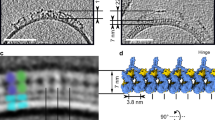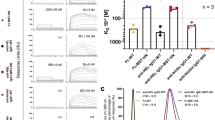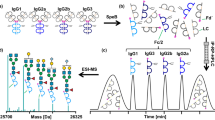Abstract
To establish the mechanism by which IgG, aggregating with antigen1, triggers the first complement component2 (the C1q·C1r·C1s complex), it is important to distinguish the potential sites on the Fc region which may be involved in the interaction. Several studies have implicated the CH2 region of IgG3–5. C1 binds weakly to monomeric IgG but strongly to aggregated IgG6,7, and an analytical ultracentrifugation study of the binding of different IgG subclasses to the C1q subunit suggested that each C1q molecule may have from 12 to 18 receptor sites for immunoglobulin8. Although there are conflicting reports of conformational changes in antibody molecules induced by antigens9–11, electron microscopic studies of rabbit IgG antibody12 have shown that reduction of a single disulphide bond between the heavy chains in the hinge region allows this immunoglobulin, on contact with its antigen, to undergo strain-release conformational changes in the Fc region, suggesting a potential energy release and perhaps exposure of a cryptic site. Chemical modification of the tryptophanyl residues of both rabbit and human IgG or their Fc fragments has been shown to reduce then-C1-fixing potentials13,14. These findings, together with examination of crystallographic structural data15 and amino acid sequence analyses16,17 of the CH2 region of human IgG1, support the possibility that a tryptophanyl residue in position 277 on human IgG (near the hinge region) could be in or near a site involved in the reaction with C1q. To explore this possibility, we have synthesised a series of small peptides resembling the portion of the CH2 region around the tryptophanyl residue at 277 (Table 1). A series of C1 consumption, C2 destruction, and C3 conversion tests was used to determine the most effective sequence for complement activation and to gain information about the functional nature of the interactions between the peptides and the human complement system. On the basis of these experiments we suggest that the primary structure of a small peptide segment is necessary for effective C1 binding and activation and that conformational changes caused by the reaction of IgG molecules with antigens, by heat aggregation, or by interfacial forces18 may expose this cryptic biologically active sequence.
This is a preview of subscription content, access via your institution
Access options
Subscribe to this journal
Receive 51 print issues and online access
$199.00 per year
only $3.90 per issue
Buy this article
- Purchase on SpringerLink
- Instant access to full article PDF
Prices may be subject to local taxes which are calculated during checkout
Similar content being viewed by others
References
Waldesbuhl, M., Allen, R., Meylen, A. & Isliker, H. Immunochemistry 7, 185–197 (1970).
Knobel, H. R., Heusser, C., Rodrick, M. L. & Isliker, H. J. Immun. 112, 2094–2101 (1974).
Connell, G. E. & Porter, R. R. Biochem. J. 124, 53P (1971).
Colomb, M. & Porter, R. R. Biochem. J. 145, 177–183 (1975).
Ellerson, J. R., Yasmeen, D., Painter, R. H. & Dorrington, K. J. FEBS Lett. 24, 318–322 (1972).
Ishizaka, T., Ishizaka, K., Salmon, S. & Fudenberg, H. H. J. Immun. 99, 82–88 (1967).
Augener, W., Grey, H. M., Cooper, N. R. & Müller-Eberhard, H. J. Immunochemistry 8, 1011–1020 (1971).
Schumaker, V. N., Calcott, M. A., Spiegelberg, H. L. & Müller-Eberhard, H. J. Biochemistry 15, 5175–5181 (1976).
Kelly, K. A., Sehon, A. H. & Froese, A. Immunochemistry 8, 613–615 (1971).
Metzger, H. Contemp. Topics molec. Immun. 7, 119–152 (1978).
Young, N. M. & Williams, R. E. Molec. Immun. 16, 145–152 (1979).
Seegan, G. W., Smith, C. A. & Schumaker, V. N. Proc. natn. Acad. Sci. U.S.A. 76, 907–911 (1979).
Allan, R. & Isliker, H. Immunochemistry 11, 175–180 (1974).
Johnson, B. J. & Thames, K. E. J. Immun. 117, 1491–1494 (1976).
Deisenhofer, J., Colman, P. M., Epp, O. & Huber, R. Hoppe-Seyler's Z. physiol. Chem. 357, 1421–1434 (1976).
Edelman, G. M. et al. Proc. natn. Acad. Sci. U.S.A. 63, 78–85 (1969).
Wang, A. C. & Fudenberg, H. H. Nature 240, 24–26 (1972).
Boackle, R. J., Pruitt, K. M. & Mestecky, J. Immunochemistry 11, 543–548 (1974).
Johnson, B. J. & Trask, E. G. J. org. Chem. 33, 4521–4524 (1968).
Rapp, H. J. & Borsos, T. Molecular Basis of Complement Action, 1–109 (Appleton-Century Crofts, New York, 1970).
Boackle, J. B. Carsgo, E. A. Adv. exp. med. Biol. 107, 411–421 (1978).
Boackle, R. J., Pruitt, K. M., SUverman, M. S. & Glymph, J. L. Jr J. dent. Res. 57, 103–110 (1978).
Greenblatt, J., Boackle, R. J. & Schwab, J. H. Infect. Immun. 19, 296–303 (1978).
Author information
Authors and Affiliations
Rights and permissions
About this article
Cite this article
Boackle, R., Johnson, B. & Caughman, G. An IgG primary sequence exposure theory for complement activation using synthetic peptides. Nature 282, 742–743 (1979). https://doi.org/10.1038/282742a0
Received:
Accepted:
Issue date:
DOI: https://doi.org/10.1038/282742a0
This article is cited by
-
The binding site for C1q on IgG
Nature (1988)
-
The C1q receptor site on immunoglobulin G
Nature (1980)



